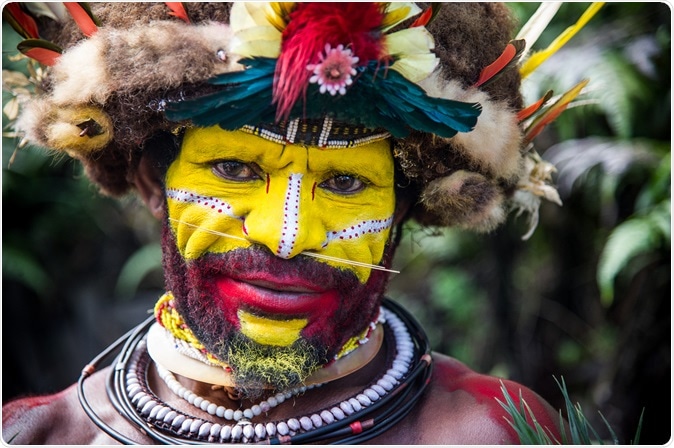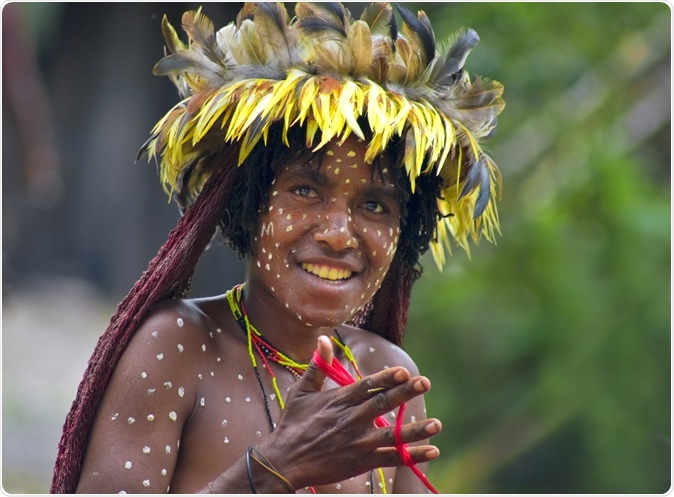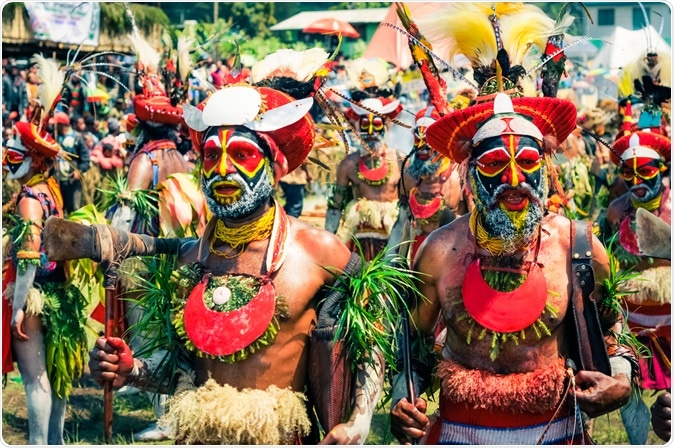According to a new report by researchers from UK, the population of Papua New Guinea has the greatest linguistic and genetic diversity. The language differences across the bends of the river Sepik are baffling and reflect and underlying genetic diversity that was until now not fully appreciated. The study report is published today 15th of September 2017 in the journal Science.

Male Huli tribe member in Tari area of Papua New Guinea in traditional clothes and face paint. Image Credit: By Amy Nichole Harris / Shutterstock
Papua New Guinea is called a “stepping stone” in the human movement from Asia to Australia by the researchers. The team of researchers note that the differences in the genetic makeup of the population can be dated back to ten to twenty thousand years only rather than fifty thousand years back when humans first arrived. They found that agriculture was independently found on this island around ten thousand years ago, and this did not change the genetic makeup of the population as was the case in several populations across Europe and in some regions of Asia.

Woman of a Papuan tribe in traditional clothes and coloring in New Guinea Island. Image Credit: Byelikova Oksana / Shutterstock
Anders Bergström, a graduate student at the Wellcome Trust Sanger Institute in Hinxton, UK, who was part of the study team, explained that agriculture tends to homogenize the genetic differences in populations. Sanger Institute geneticist Chris Tyler-Smith, lead researcher further explained that in the Europe for example when agriculture was brought in by the Anatolia farmers, the genetic makeup of the local hunter gatherers that lived then for generations completely got replaced by the new genetic features. This obliteration of the genetic picture is absent in New Guinea and this is a “big surprise” he said.

Traditional Enga cultural show in Wabag, Papua New Guinea. Image Credit: Michal Knitl / Shutterstock
For this study the team looked at 1.7 million DNA markers across the genes of 381 Papua New Guinea citizens speaking 85 different languages. For 39 other individuals from the regions they obtained and compared the complete genetic picture. Results revealed were surprising.
They found;
- Residents of Papuan New Guinea were isolated and different from the Asians in the prehistorical periods
- The persons dwelling in the highlands and the lowlands were separated from each other ten to twenty thousand years ago
- Those living in the highlands again divided into three groups within the last ten thousand years after agriculture began
- The lowlanders on the other hand divided into two groups, one each for north and south
According to Bergström, agriculture techniques along with the genes began to spread simultaneously initially. Then the groups stop intermixing and further genetic exchange could not take place. This meant that the local genetic pool remained intact for each of the separated groups. Initially it was thought that the mountains were keeping the highlanders off the lowlands preventing genetic exchange and homogenization. Then it was noted that the genetic uniqueness was maintained even in the plains where the groups could easily mix around. The team speculates that there may be within group marriages and also intergroup wars and segregations that were keeping the people from different groups from procreating together and mixing the genetic types.
This study was hailed as an important landmark by experts in understanding the genetic diversity shown by populations and understanding of how technology and movements across countries can still affect the genetic changes in the populations.